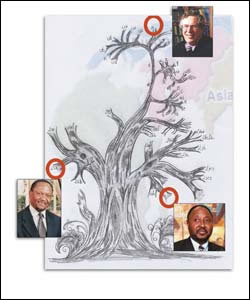We are all Africans
26 September 2005
Branching out: Prof Himla Soodyall's genetic heritage tree, with its roots in Africa, pinpoints the maternal lineage of Prof Njabulo Ndebele (left), Prof Thandabantu Nhlapo (right) and Hugh Amoore (top).
Most of us can name our grandparents, many our great-grandparents and some our great-great-grandparents. Beyond this, for the vast majority of us, the past is unknown. Where did we come from? Where and when did our ancestors live? When did humans first inhabit different parts of the world?
Genetic studies have contributed significantly in shedding light on these questions. The genetic approach is based on studying DNA - the blueprint of life - in living peoples, and then reconstructing the history of changes in the DNA to a common point back in the past.
The geographic region of origin of the most recent common ancestor of all living people is in Africa (about
Professor Himla Soodyall, director of the Human Genomic Diversity and Disease Research Unit at the University of Witwatersrand, took a novel approach to this topic by inviting three members of UCT's senior leadership group to participate in a test to shed light on their specific genetic heritage.
Vice-chancellor Professor Njabulo Ndebele, deputy vice-chancellor Professor Thandabantu Nhlapo and registrar Hugh Amoore were the willing guinea pigs for her lecture on September 8, which looked at the African link in genetic heritage.
An acclaimed researcher and academic, Soodyall has been invited by the National Geographic Society to participate in the global Genographic Project, as the Sub-Saharan African principal investigator.
She was also the scientist behind the M-Net television programme called So where do we come from? in which luminaries like former president Nelson Mandela, Pieter-Dirk Uys and Naas Botha participated.
For both the TV programme and the UCT lecture, Soodyall took a cheek swab from the volunteers, which was tested for the ancient maternal line, looking at mitochondrial DNA (mtnDNA) sequence profiles, as well as the paternal line from the Y chromosome.
Soodyall explained that while these tests were able to show lineages back to the "clan mothers" and "clan fathers", they were not able to shed light on all the missing relatives in-between.
In the case of Ndebele, she found that his maternal line (L2a) stretches back some 34 000 years in a sub-lineage that is commonly observed throughout West Africa, East Africa, Central Africa and Southern Africa. In addition, she found one individual on her database with an identical match with whom he shares a maternal ancestor in the not-so-distant past.
Nhlapo's mtnDNA line (L1d), which dates back some
Amoore's mtnDNA (H) was linked to that of "Helena", one of the seven daughters of Eve, in the book of the same name by Bryan Sykes. About 45% of Europeans have this lineage, which is thought to have evolved somewhere in the Dordogne region in southern France some 20 000 years ago.
Concluding her lecture, Soodyall remarked: "Irrespective of the fact that we have these differences, the main point is that this heritage comes back to our doorstep."
Citing President Thabo Mbeki's famous "I am an African" speech, she added: "I think we all feel a sense of pride and being at home - it doesn't matter what colour we are - when we think about where we currently reside–
"It is time that, as scientists and academics, we stood up to be counted to try to advance people, irrespective of who they are, in terms of that spirit of solidarity. I believe that by extending this hand we have a much, much stronger future for the new generation to really appreciate the heritage that we are privileged to have."
 This work is licensed under a Creative Commons Attribution-NoDerivatives 4.0 International License.
This work is licensed under a Creative Commons Attribution-NoDerivatives 4.0 International License.
Please view the republishing articles page for more information.










